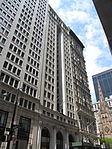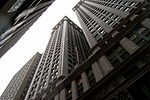Lower Manhattan

Lower Manhattan, also known as Downtown Manhattan or Downtown New York, is the southernmost part of Manhattan, the central borough for business, culture, and government in New York City. Lower Manhattan is defined most commonly as the area delineated on the north by 14th Street, on the west by the Hudson River, on the east by the East River, and on the south by New York Harbor (also known as Upper New York Bay). The Lower Manhattan business district, known as the Financial District, forms the main core of the area below Chambers Street. The city had itself originated at the southern tip of Manhattan Island in 1624, at a point that now constitutes the present-day Financial District. The population of the Financial District alone has grown to an estimated 61,000 residents as of 2018, up from 43,000 as of 2014, which in turn was nearly double the 23,000 recorded at the 2000 Census.
Excerpt from the Wikipedia article Lower Manhattan (License: CC BY-SA 3.0, Authors, Images).Lower Manhattan
Broadway, New York Manhattan
Geographical coordinates (GPS) Address Website Nearby Places Show on map
Geographical coordinates (GPS)
| Latitude | Longitude |
|---|---|
| N 40.7078 ° | E -74.0119 ° |
Address
Trinity Church
Broadway
10006 New York, Manhattan
New York, United States
Open on Google Maps









